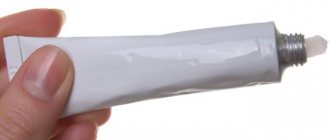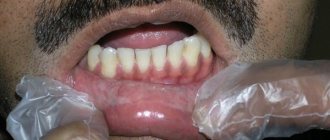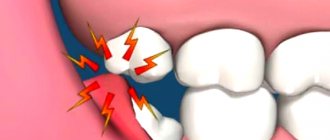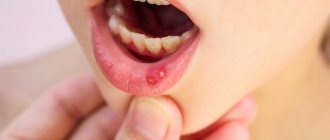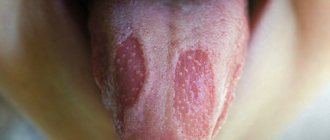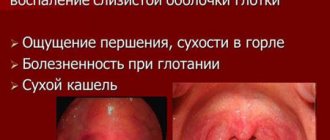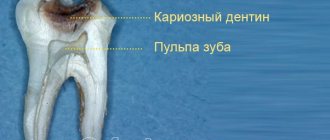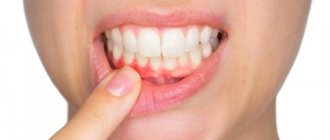Are you familiar with the feeling of burning and itching on your lips? Or the unexpected appearance of bubbles on the skin of the face and lips? 95% of the people on the planet know what I'm talking about. True, not everyone pays due attention to these things. Let's start with the fact that any inflammation of the oral mucosa is called STOMATITIS. But in this article we will talk about the most common disease in the world as a whole, popularly called HERPES. Namely, we will consider herpetic stomatitis, etiology, pathogenesis, clinic and treatment of this disease.
ETIOLOGY OF HERPETIC STOMATITIS
The etiology of herpetic stomatitis is simple. If there is a virus, there are diseases. The virus that causes herpetic stomatitis belongs to the HERPES VIRIDAE family. This family includes about 80 different viruses, and, note, 8 of which cause human illness. Herpetic stomatitis is caused by the herpes simplex virus type 1 (HSV-1), and if it was a congenital or intrauterine (neonatal) infection, then this infection occurred with the herpes simplex virus type 2 (HSV-2).
It would seem that the virus is simple - the infection is simple. But the herpes simplex virus itself is very cunning and insidious. This virus, the herpes simplex virus, has come up with 4 ways of entering the human body:
- Airborne (therefore, it is recommended to avoid people with visible manifestations of the virus);
- Contact (lips affected by herpes are unlikely to give pleasant kisses);
- Transplacental (that is, from mother to child);
- Transfusion (with blood transfusion).
Herpes or stomatitis
Not everyone knows how to distinguish herpes from stomatitis. Usually people prefer to self-medicate without really finding out what they are sick with.
Despite the fact that at first glance both of these diseases are similar, they are somewhat different and how exactly - it is necessary to know in order to make a correct diagnosis.
For greater clarity, we presented the main differences between herpes and stomatitis in a summary table:
| Criterion | Stomatitis | Herpes |
| Location | Closer to soft tissues (cheeks, tongue, etc.). | Near the bone, that is, on the surface of the gums. |
| First signs | Immediately sores. | Blisters with an average diameter of 2 mm, which later develop into ulcers. |
| Features of distribution | Constantly changes its place, there is no clear location. | Localization is strict, that is, pimples always appear in the same place. |
Thanks to the above parameters, we can conclude that herpes is quite easily distinguished from stomatitis. With a correct diagnosis, treatment can be faster and more effective. However, even if you are completely confident in any disease, it is better to consult a professional.
Stomatitis on the lip
PATHOGENESIS OF HERPETIC STOMATITIS
The pathogenesis of herpetic stomatitis is quite complex and not fully understood. It is not fully explained by what factors the inner shell of the virus is dissolved, what viral factors allow it to penetrate DNA - human cells, and why the virus, when it is inactive (that is, there are no clinical manifestations) cannot be treated.
However, scientists believe that at the time of infection, the herpes simplex virus attaches to specific receptors on the cell membrane (cells that are sensitive to HSV). Then the fusion of the cell membrane and the outer shell of the virus occurs. At the moment of such penetration, the cell membrane of the cell is not damaged, but the virus seems to bud inside. Then cellular enzymes work, those that dissolve the inner shell of the virus and the “naked” virus penetrates the DNA of the host cell. And the herpes simplex virus can remain in this state for a long time until the provoking factors work.
FACTORS PROVOKING RECURRENCE OF HERPETIC STOMATITIS
Factors that provoke relapse of herpetic stomatitis represent a large group. In principle, herpes can be triggered by anything, from climate change and time zone to ARVI and other infections. And so, the group of factors that provoke a relapse of herpetic stomatitis includes:
- Any change in body temperature (hypothermia is more favored by the herpetic stomatitis virus);
- Decreased immunity (any infection, etc.);
- Trauma to mucous membranes and skin;
- Stress, overwork or overexertion;
- Consumption of alcoholic beverages;
- Smoking;
- Menstruation;
- Change of climate and time zone;
- Taking medications.
As you can see from the lists, there are many factors, and the virus is just waiting for the body to give up. Children from 6 months to one year get sick due to the cessation of protective proteins from the mother. Therefore, let's talk about the prevention of herpetic stomatitis.
Causes
The causes of herpes and stomatitis are slightly different, so let's talk about them separately.
Stomatitis
The nature of the development of stomatitis has not yet been precisely clarified. It is assumed that this is the result of the body’s reaction to the penetration of any unknown microorganisms. As a result of this reaction, the process of accumulation of lymphocytes and the formation of ulcers begins around the source of infection. However, factors contributing to the development of this disease are now known. These include:
- poor nutrition - especially lack of vitamin B12, folic acid;
- the use of certain medications, or rather their overdose;
- alcoholic drinks, drugs;
- stressful situations;
- viruses, bacteria, as well as other diseases that weaken the immune system (influenza, ARVI and other pathologies);
- injury to the gums and the oral mucosa in general;
- consumption of large quantities of confectionery products, as well as potatoes, citrus fruits and coffee;
- contact with infected patients;
- lack of sleep;
- in young children, a particularly high risk of developing stomatitis occurs during the period of teething, due to injury to the gums;
- genetic predisposition of the body to this disease.
Herpes
The causes of herpes are the human herpes virus (HHV). Usually people develop immunity to it from 0.5 to 1 year. At this age, the immunity received from the mother is already weakening enough, and a new one, one’s own, has not yet had time to develop. Therefore, primary herpes most often occurs in children.
In general, the prerequisites for the development of herpetic infection and relapse may be:
- frequent stressful conditions;
- diseases that weaken the immune system (flu, ARVI);
- chronic immune deficiency diseases (AIDS);
- genetic predisposition;
- disruptions in the functioning of the hormonal system;
- hypothermia caused by critically low temperatures;
- exposure to various types of radiation, for example solar;
- poor nutrition;
- lack of sleep;
- lack of personal hygiene.
ARVI is one of the reasons for the development of herpes
After infection, an incubation period begins, lasting, depending on the state of the immune system, from 8 days to 3 weeks. After this, there are two possible developments:
- The body defeats the disease, the virus enters the dormant stage, waiting for an opportunity to manifest itself again. This usually occurs when external conditions are formed that adversely affect the state of the immune system.
- The body cannot suppress the infection on its own. In this case, medical intervention is necessary, otherwise there is a high risk of complications of the disease.
PREVENTION OF HERPETIC STOMATITIS
Prevention of herpetic stomatitis should be carried out not only after a person has had symptoms of herpes, but also before birth. That is, work should be carried out with parents both by an obstetrician-gynecologist and a dentist. The simplest rules for preventing herpetic stomatitis are:
- Use of masks;
- Careful hand hygiene;
- Use of personal hygiene products;
- Individual dishes, towels, etc.;
- Bans on kissing;
- Prohibition on tasting food;
- General cleaning of the premises;
- Ventilation;
- Hardening the body;
- Good nutrition;
- Physical activity;
- Timely treatment of common diseases.
But if you or your child come into contact with a person who suffers from herpetic stomatitis, it is recommended to lubricate the oral mucosa with antiviral ointments (for example, acyclovir) for 5 days, or prevention may involve taking interferon.
Treatment
Treatment of herpes infection should begin when the first symptoms of infection appear. In this case, it will be possible to stop the further spread of the virus and get rid of external manifestations quickly enough. You must understand that the later treatment begins, the harder it will be to suppress the disease. The disease should be combated with special antiviral drugs, such as acyclovir and its derivatives (valaciclovir, famciclovir).
Since the mucous membrane in general is quite delicate, it may be necessary to take special painkillers, for example:
- dyclonine hydrochloride (0.5%);
- lidocaine (2%).
These solutions must be kept in the mouth for about 3 minutes and then spat out. They must not be swallowed. If the pain does not subside, you can take gels of more powerful painkillers, for example, Kalgel. These products are applied directly to problem areas 3 times a day.
In case of complications of the disease, fever, general malaise, drugs such as ibuprofen, nurofen and other painkillers and anti-inflammatory drugs are used.
Treatment of ordinary stomatitis includes taking local anesthetics (it is worth noting that lozenges are not recommended because they can cause even more wounds and ulcers). Treatment of the underlying cause of the disease also includes taking medications to promote faster wound healing.
Be sure to read the article about the treatment of stomatitis on our portal. There you will learn about how to properly treat different types of this disease, such as candidiasis, ulcers and others.
It is worth noting separately that during the treatment of the described infections it is necessary to adhere to some dietary restrictions, namely:
- do not drink fruit juices;
- drink more clean water;
- refuse rough food;
- do not eat smoked or fried foods;
- try to give up spices and seasonings.
SYMPTOMS OF HERPETIC STOMATITIS
Knowing the symptoms of herpetic stomatitis is very helpful for timely treatment. That is, it is possible to prevent a vivid clinical picture.
Symptoms of herpetic stomatitis:
- Itching;
- Burning;
- Unpleasant sensation on the mucous membranes of the lips;
- There may be chills;
- Weakness;
- Malaise;
- Headache.
These, you know, are common symptoms that are precursors to the appearance of herpes. However, in the development of herpetic stomatitis there are 4 stages, each of which has its own symptoms.
STAGES OF DEVELOPMENT OF HERPETIC STOMATITIS
The first period or the first stage is the incubation period. This period is NOT clinically manifested.
The second stage of the development of the disease is the prodromal period (it is at this stage that the general symptoms of herpetic stomatitis are observed. Remember that symptoms may vary depending on the severity of the disease, it is written about it below)
The third stage is the period of development - also the period of rashes.
The fourth stage is the period of extinction - the mucous membrane and skin are restored, and the state of health also returns to normal.
CLASSIFICATION OF HERPETIC STOMATITIS
Classification of herpetic stomatitis includes:
- Acute herpetic stomatitis;
- Chronic recurrent herpetic stomatitis;
- Herpetic geometric glossitis;
- Gladiator herpes;
- Acute herpetic infection in newborns;
- Chronic herpetic infection with manifestation in the oral cavity in certain immunodeficiency conditions.
Herpetic stomatitis is also:
- Acute (occurred for the first time);
- Chronic.
ELEMENTS OF HERPETIC STOMATITIS
There is a certain order in which the elements of herpetic lesions appear on the red border of the lips.
First, a papule appears (a painless compaction in the form of a whitish nodule), then a bubble with contents appears (the contents can be transparent, it can be cloudy), after the bubble a crust appears, the crust has disappeared, and a spot appears in its place. And then everything is restored.
When the mucous membrane of the oral cavity is affected, there are some peculiarities. It all starts with a spot, which then turns into a vesicle (bubbles, as I said, can be either with transparent contents or with cloudy content), after the vesicle erosion occurs (hyperemic, painful, sensitive to irritants, an open area of the mucous membrane), which will turn into aphtha ( formation with a rim of redness along the edge of the element, whitish inside). And then again the stain and restoration.
General information
Stomatitis is an infection that affects the mucous membrane of the mouth and manifests itself as:
- inflammation;
- small pimples;
- blisters;
- ulcers and rashes that cause quite severe discomfort to the sick person.
Be sure to read the large article about stomatitis on our website to learn more about the causes, symptoms and treatment of this disease.
Most often, these signs appear on the tip of the tongue, its left and right parts, as well as under and above the tongue.
Herpes is a viral disease that also affects the skin.
ACUTE HERPETIC STOMATITIS
Acute herpetic stomatitis occurs for the first time. And the severity of the infection (from mild to severe) depends, firstly, on the aggressiveness of the virus itself, and secondly, on the host’s immunity. Therefore, in some cases, the infection goes away on its own, as if “self-limiting”: after two weeks, visible clinical recovery occurs, and the incubation period begins again. In other cases, when the immune defense is not very strong, the virus can spread to other organs and systems, leading to the generalization of herpes infection.
Let's consider each form of acute herpetic stomatitis.
Mild form of acute herpetic stomatitis
A mild form of herpetic stomatitis in the prodromal period is characterized by:
- slight increase in body temperature (no more than 37 - 37.5 degrees)
- development of catarrhal gingivitis;
- enlarged lymph nodes;
- duration no more than 1 – 2 days.
The mild form of herpetic stomatitis during the development period is characterized by:
- the appearance of single lesion elements (!the number of bubbles does not exceed the number 5!);
- maintaining hyperemia of the oral mucosa;
- preservation of enlarged lymph nodes.
- The duration of the period is 1-2 days.
A mild form of herpetic stomatitis during the period of extinction is characterized by:
- By reducing all elements of the lesion in size, their healing occurs (epithelialization),
- Normalization of the size of lymph nodes;
- Normalization of body temperature;
- Reducing mucosal hyperemia
- The period is longer.
2) Moderate form of herpetic stomatitis
The average form of herpetic stomatitis in the prodromal period is characterized by:
- Appearance of weakness, sleep disturbances, appetite disorders;
- Increased body temperature to 37.5 degrees;
- Increased size of lymph nodes.
The average form of herpetic stomatitis during the development period is characterized by:
- Chills, weakness, headache;
- Increased body temperature to 39 degrees;
- The presence of up to 25 elements of damage;
- Generalized catarrhal gingivitis;
- Bleeding gums;
- Increased salivation.
The average form of herpetic stomatitis during the period of extinction is characterized by:
- Restoring general well-being;
- Normalization of the size of lymph nodes;
- Healing of lesions.
3) Severe form of acute herpetic stomatitis
The severe form of acute herpetic stomatitis is less common than other forms and occurs in people with very weak immunity. Most often with severe immunodeficiencies.
The severe form of herpetic stomatitis in the prodromal period is characterized by:
- Apathy;
- Headache;
- Skin and muscle changes such as hyperesthesia may be observed;
- Changes in the cardiovascular system such as bradycardia, tachycardia, hypotension;
- Nausea, vomiting, bleeding from the nose and throat;
- Inflammation of the lymph nodes not only in the jaw area, but also in the neck.
The severe form of herpetic stomatitis during the development period is characterized by:
- Body temperature is more than 39 degrees;
- The oral mucosa is swollen and hyperemic;
- There is dryness of the lips, possible cracking;
- The number of damage elements is more than 100!
- Ulcerative gingivitis;
- Increased salivation with blood.
The severe form of herpetic stomatitis during the period of extinction depends on the body’s immunity and often complete and high-quality healing does not occur.
CHRONIC RECURRENT HERPETIC STOMATITIS
Like acute herpetic stomatitis, chronic recurrent herpetic stomatitis goes through 4 stages of the disease and has three forms. The only difference is that the form of chronic recurrent herpetic stomatitis is determined not by the number of lesions (up to 5, up to 25 or more than 100), but by the frequency of occurrence per year.
The mild form of chronic recurrent herpetic stomatitis is characterized by the occurrence of lesions 1 – 2 times every 3 years;
The average form of chronic recurrent herpetic stomatitis is characterized by the occurrence of lesions 1 – 2 times a year;
The severe form of chronic recurrent herpetic stomatitis is characterized by the occurrence of lesions 4 or more times a year.
In chronic recurrent herpetic stomatitis, single or group elements of the lesion are detected, most often in the form of small blisters, which then appear, forming erosions. The mucous membrane is swollen and hyperemic. In severe cases of chronic recurrent herpetic stomatitis, a deterioration in the patient’s general well-being, headache, weakness, and body temperature of more than 39 degrees are added.
DIFFERENT DIAGNOSTICS OF HERPETHIC STOMATITIS
Differential diagnosis of herpetic stomatitis is carried out with chronic aphthous stomatitis, with exudative erythema multiforme, and with pemphigus vulgaris.
If we compare herpetic stomatitis and chronic aphthous stomatitis, then both lesions have aphthae. However, with aphthous stomatitis they are single, round, covered with a whitish coating and surrounded by a halo of hyperemia, there is no catarrhal gingivitis, the lymph nodes are not enlarged, and there is no elevated body temperature.
The differences between herpetic stomatitis and exudative erythema begin with the time of year. Most often, erythema occurs in autumn and spring and immediately begins to become difficult. That is, it is characterized by total damage to the mucous membrane, hyperemia, and edema. Erosions and ulcers are large, massive hemorrhagic crusts on the red border of the lips, cracks. The general condition also suffers: body temperature more than 40 degrees, weakness, malaise, multiple bluish spots (cockades) on the skin of the hands.
The difference with pemphigus vulgaris is that with pemphigus there are erosions that are slightly painful, located on the visually healthy mucous membrane of the oral cavity.
